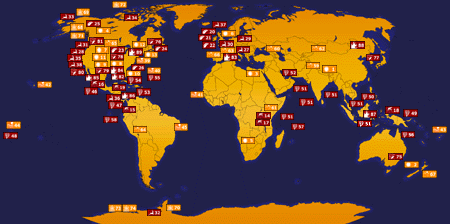The “Early Warning Signs Map” is a poster-sized map of the world that illustrates global climate change as it’s happening. It shows global warming Fingerprints (where you can see it happening now) and Harbingers (what it may well look like). Click on a continent to explore local indicators of global warming. The map was produced by seven major conservation organizations including the Union of Concerned Scientists and Natural Resources Defense Council. There is also a Curriculum Guide to use with the map. http://www.climatehotmap.org
It might be interesting to see how this map matches the World Energy Council’s on-line database of worldwide voluntary greenhouse gas emissions reductions. Companies and organizations can publicly demonstrate what they are doing to reduce emissions by contributing to the database. It also enables financial institutions and groups seeking emissions offsets to identify promising projects that may merit financial support. The system allows emission reduction projects to be recorded and tracked as they proceed; reductions are totalled by country and by type of greenhouse gas emission. http://www.worldenergy.org
How do you calculate greenhouse gases? The GHG Protocol Initiative shows you how. A multi-stakeholder collaboration convened by World Resource Institute and the World Business Council on Sustainable Development is testing a version of its corporate greenhouse gas inventory standard. Their goal is to design, disseminate, and promote the use of an international corporate protocol for measuring and reporting business greenhouse gas emissions.
The protocol includes: a reporting standard (how to measure and report); estimation and reporting guidance (inventory goals, ownership/control of emissions, baselines); and estimation tools (tools to use to collect information and estimate emissions). http://www.ghgprotocol.org
A new web site from The Business Council for Sustainable Development of Latin America, www.climategateway.com, promotes the effort the Latin American private sector is making to mitigate green-house gas emissions. There are company case studies and background information on the Latin American experience. An on-line course, the “ABCs of Climate Change” will be offered on the site soon. To monitor climate change issues, you might turn to ClimateGuru.com. This new web portal tracks scientific, policy, technical, and media information concerning global climate change. The US Global Change Research Program also has a web site at [sorry this link is no longer available]. The program, funded to the tune of $1.7 billion a year, is coordinated through the National
Science and Technology Council’s Committee on Environment and Natural Resources, and embraces activities in nine Federal agencies. It’s a good place to look for federal information, background on the scientific basis for climate change and major national and international studies.
Scenarios for a Clean Energy Future, a publication from the U.S. Department of Energy, details policies that could reduce U.S. emissions up to 30 percent by 2020, while reducing petroleum dependence and inefficiencies in energy production and use. The policy tools they discuss – voluntary agreements, efficiency standards, increased energy research, development and demonstration, electric sector restructuring, and domestic carbon trading – have comparable costs and benefits. [sorry this link is no longer available]
